Feature
Taking the Maker Experience From a Local Phenomenon to National Implementation
Connected Science Learning July-September 2018 (Volume 1, Issue 7)
By Chip Lindsey, Lisa Brahms, and Kathryn Koffler
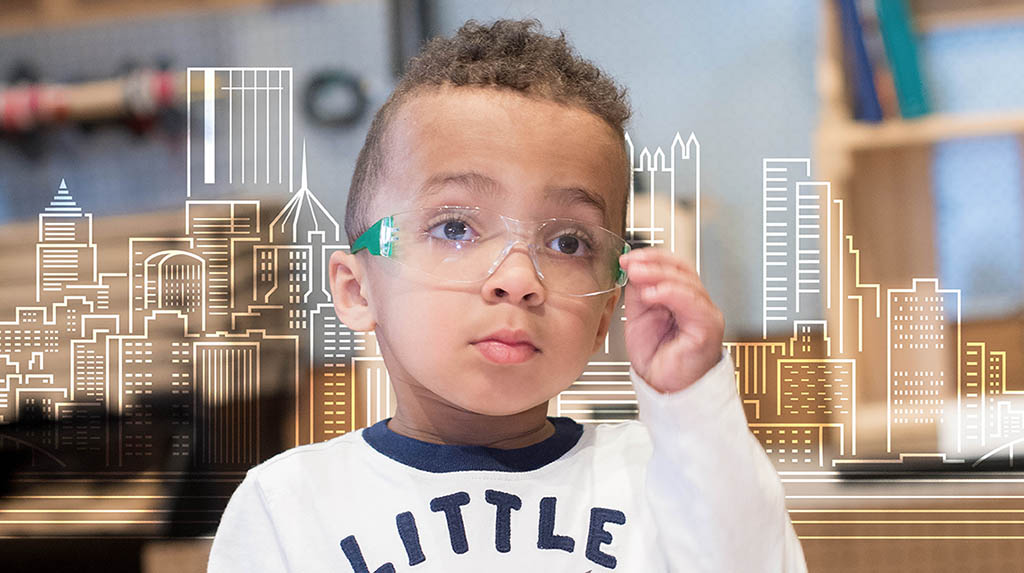
MAKESHOP at the Children’s Museum of Pittsburgh is open for all to experience hands-on building and tinkering, and their initiative has spread nationwide.
The maker movement has swept across the country over the last decade as a means to ignite creativity and support STEM (science, technology, engineering, and math) education (e.g., NYSCI 2013; Peppler and Bender 2013; Honey and Kanter 2013; Sheridan et al. 2014), bring a renewed sense of relevance to school curricula (e.g., Wardrip and Brahms 2014, 2016), and support the development of innovative and entrepreneurial skills (e.g., Benton et al. 2013). Making may be thought of as building or adapting objects using real tools and real materials and engaging learners in the process of using these tools and materials. It is rare to visit a science center or children’s museum without seeing a space dedicated to making. Schools, too, have looked to the promise of physical and digital making to move traditional K–12 curricula in science and math toward engineering and technology.
With this enthusiasm comes the necessity to move beyond “a room with tools” toward a deep understanding and clear articulation of the goals and intended learning outcomes linking the activities and the people to the space.
The local phenomenon
For seven years, the Children’s Museum of Pittsburgh’s MAKESHOP exhibit has delighted visitors with a wide array of making activities and programs that are experiments in free-choice learning. Visitors to the exhibit “vote with their feet,” investigating media and techniques only if they become interested, and staying only as long as their interest and schedule allows. It is up to the teaching artists to curate activities and environments that provoke engagement across generations and cultures. The content and media shift between digital and analog; high tech and low tech; short- and long-term projects. A visitor may contribute one day to a weeklong collective weaving on a traditional loom, and the next day use an iPad to create a 10-minute digital project using stop-motion animation. The ever-shifting palette of media has served as the perfect petri dish for understanding the nature of making as a learning experience.
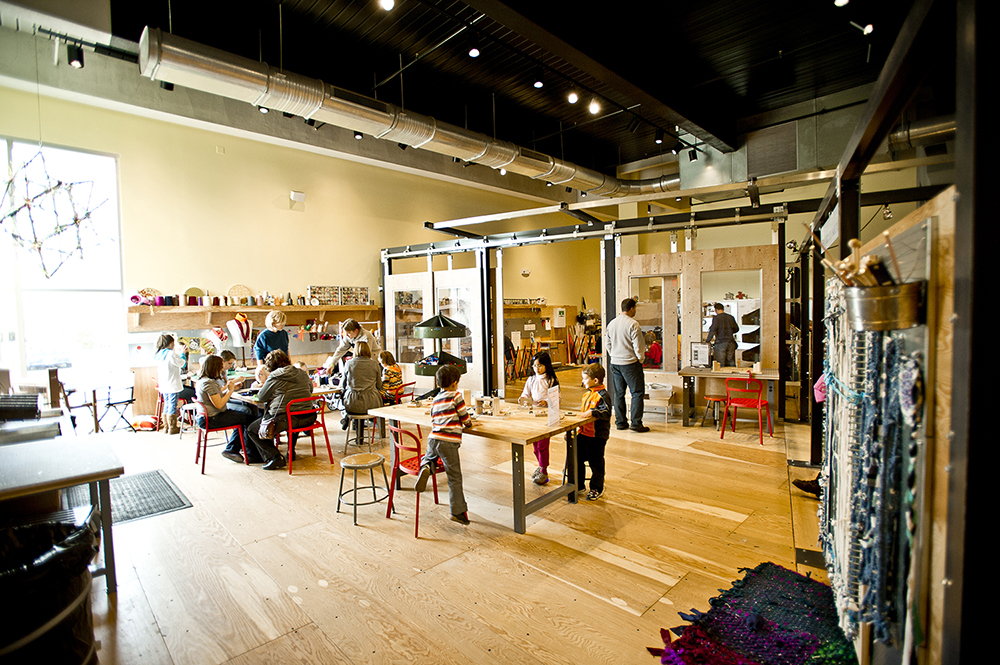
Photo by Anthony Musmanno
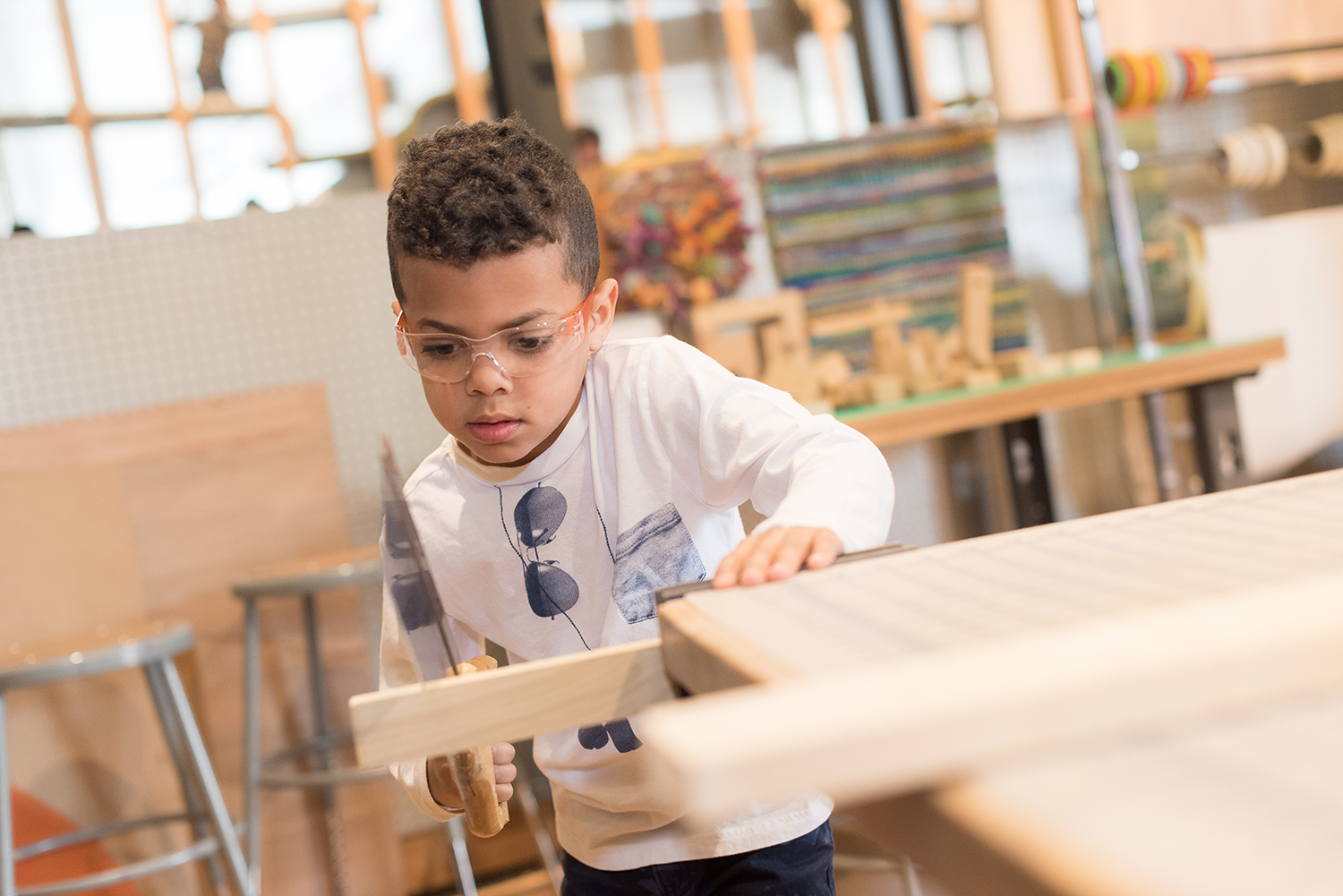
Photo by Christopher Sprowls
Visitors of all ages can experience a multitude of processes and materials, from hand and machine sewing and woodworking to computer programming. MAKESHOP is a space for hands-on building and tinkering with old and new technologies, exciting projects, and cutting-edge media for visitors of all ages. Visitors are encouraged to experience a variety of materials, processes, and techniques while trying out new ideas. MAKESHOP teaching artists skillfully watch visitors’ body language as they enter the space, looking for the moment when curiosity deepens and attention is directed toward an activity area. At that point, teaching artists invite visitors into activities with statements such as, “Would you like to do some woodworking with us?” or “We are working on an animation. Would you like to try? It takes about 20 minutes to get started.” These statements help visitors know what to engage with and how much time they will need to invest.
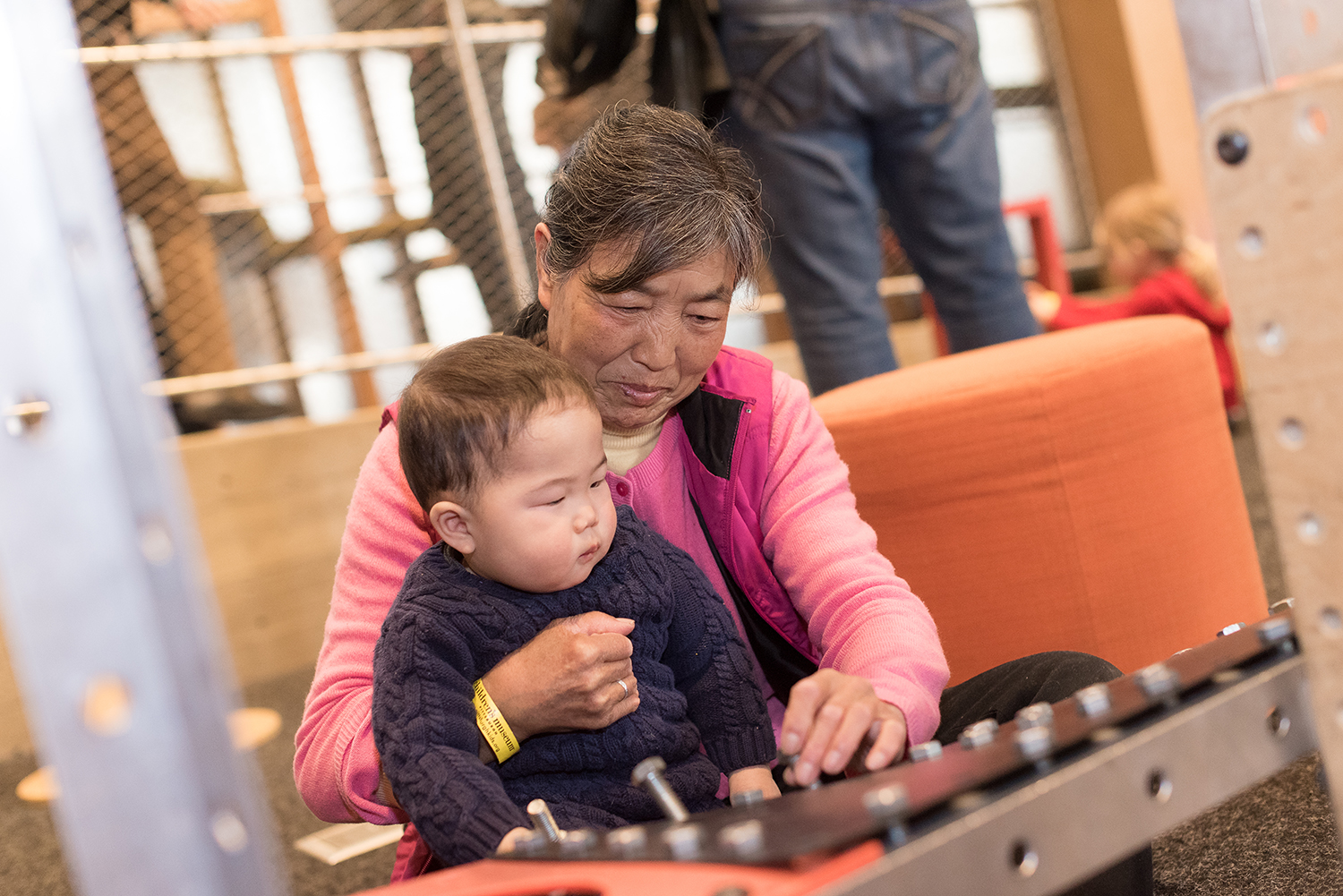
Photo by Christopher Sprowls
Visitors are encouraged to investigate how things work, discover how things are used, and learn new processes and skills. Children’s Museum of Pittsburgh’s guiding design philosophy is “play with real stuff,” which promotes the use of authentic materials and processes in all programming. Families encounter real ceramics clay, not children’s modeling clay, and framing hammers, not plastic toy hammers. Young children, once introduced to safe use, can often be found soldering circuits, using a sewing machine, or ripping wood with a saw.
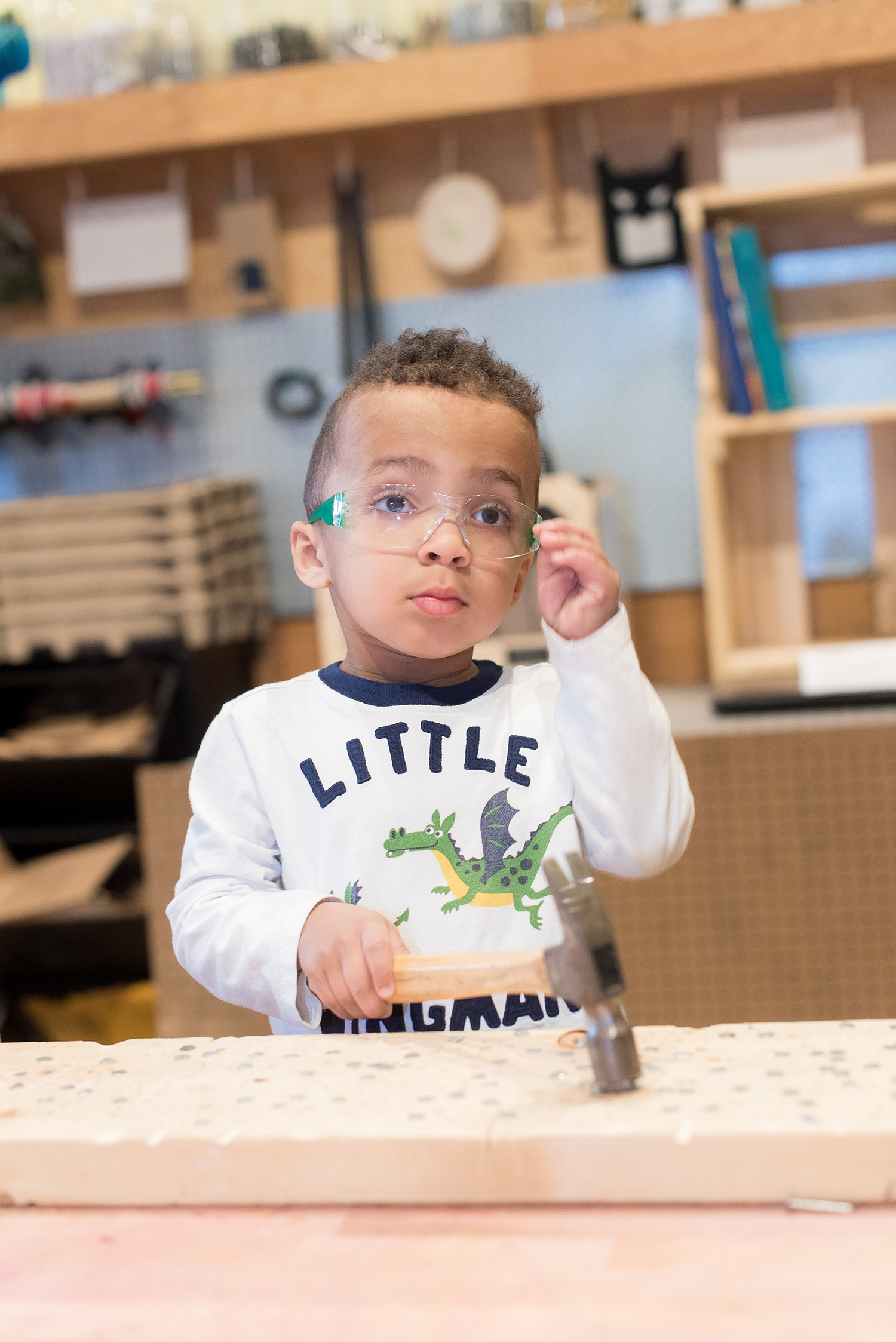
Photo by Christopher Sprowls
Exhibit goals
Since its founding in 2010, MAKESHOP’s staff have collaborated with the learning scientists from the Museum’s Learning & Research department and the University of Pittsburgh Center for Learning in Outside-of-School Environments to identify, describe, and assess the learning made possible through the design of the MAKESHOP’s space, as well as the activities and facilitation that happen within it. Through ongoing, iterative, design-based research, our team of researchers and practitioners worked collaboratively to empirically identify the Learning Practices of Making, or a set of observable and/or reportable behaviors that are evidence of engagement in making as a learning process (e.g., Brahms and Crowley 2016a; Brahms and Crowley 2016b; Wardrip and Brahms 2016; Brahms and Wardrip 2016a; Brahms and Wardrip 2016b; Wardrip and Brahms 2015; Brahms and Wardrip 2014). This perspective asserts that learning is fundamentally tied to the social and cultural contexts in which it occurs and focuses on the “practices” that define learning communities (e.g., Brown, Collins, and Duguid 1989; Lave and Wenger 1991; Gutiérrez and Rogoff 2003). By practice, we mean the “more or less coordinated, patterned, and meaningful interactions of people at work” (Spillane 2012). In other words, it is a way we aspire for our visitors to talk, work, and participate in our space. This approach focuses on the process of learning, rather than the end result. In addition, it has established, for our team, a language for and culture to support learning through design.
The Learning Practices of Making summarize and focus the learning and design goals for the design of the exhibit space, as well as the activities and facilitation within. The seven behaviors supported by MAKESHOP exist outside of specific content areas and act as fundamental skills that support STEM and 21st-century skills. We describe these practices in the following sections.
Inquire
This practice encompasses learners’ openness and curious approach to the possibilities of the making context through exploration and questioning of the material properties of an object or medium. Inquiry often forms the start of the making process and includes careful observation, exploring materials and tools, and questioning their properties and purposes. You might hear learners ask, “What does this one do?” or “Why is this not working?”
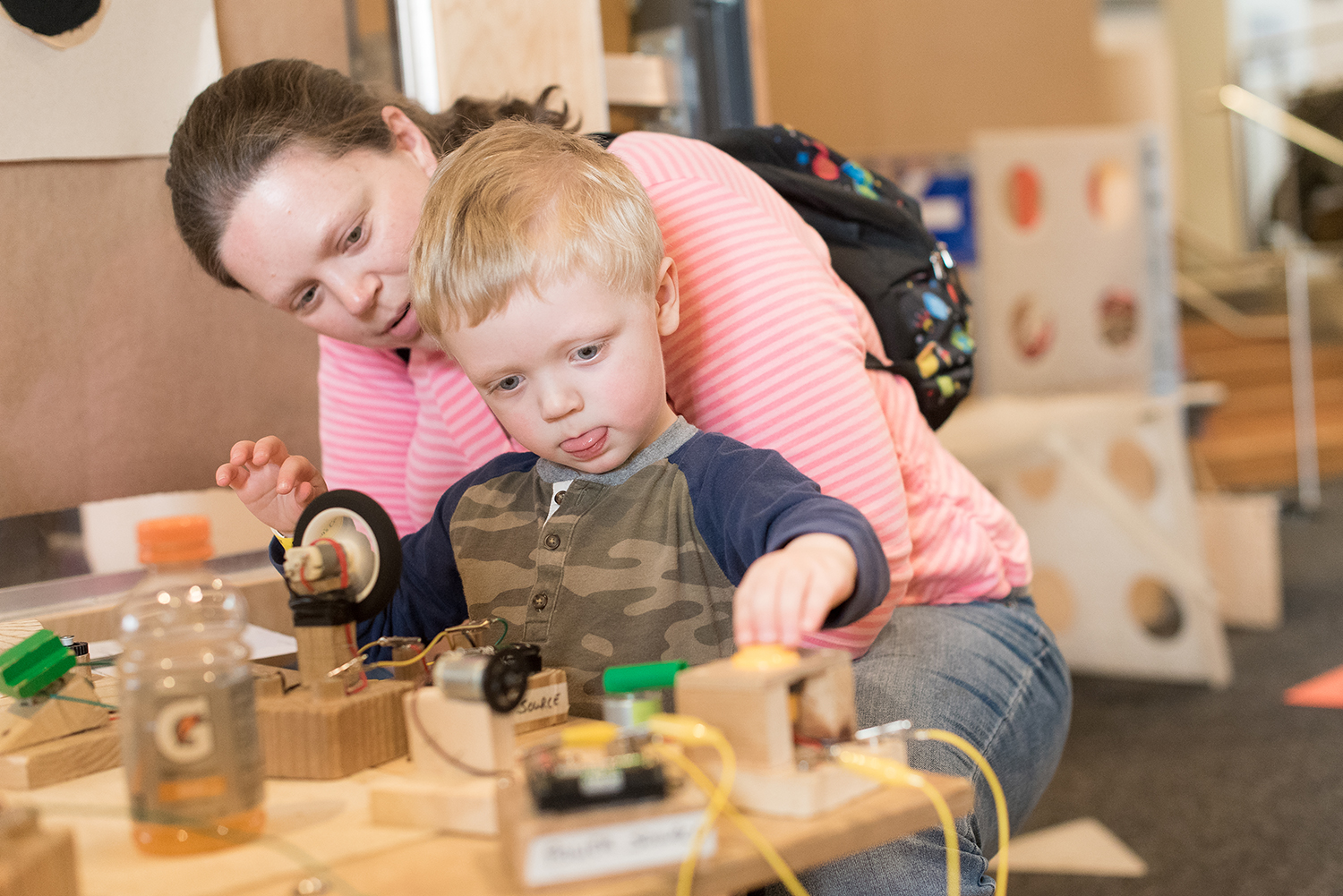
Photo by Christopher Sprowls
Tinker
This practice refers to learners’ purposeful play, testing, risk-taking, and evaluation of the properties of materials, tools, and processes. An example of tinkering can be seen when a child repeatedly tests the connection between two wooden pieces by tightening and loosening the screws, or can be heard through phrases such as, “Let’s see what happens when …”
Expression intention
This practice is related to learners’ discovery, evolution, and refinement of personal identity and interest areas through their determination of short- and long-term goals. The practice includes learners’ responsive choice, negotiation, and pursuit of goals alone and with others. This is often a verbal articulation of a goal, such as, “First let’s connect these wires together,” or “I’m going to use this for a parachute.”
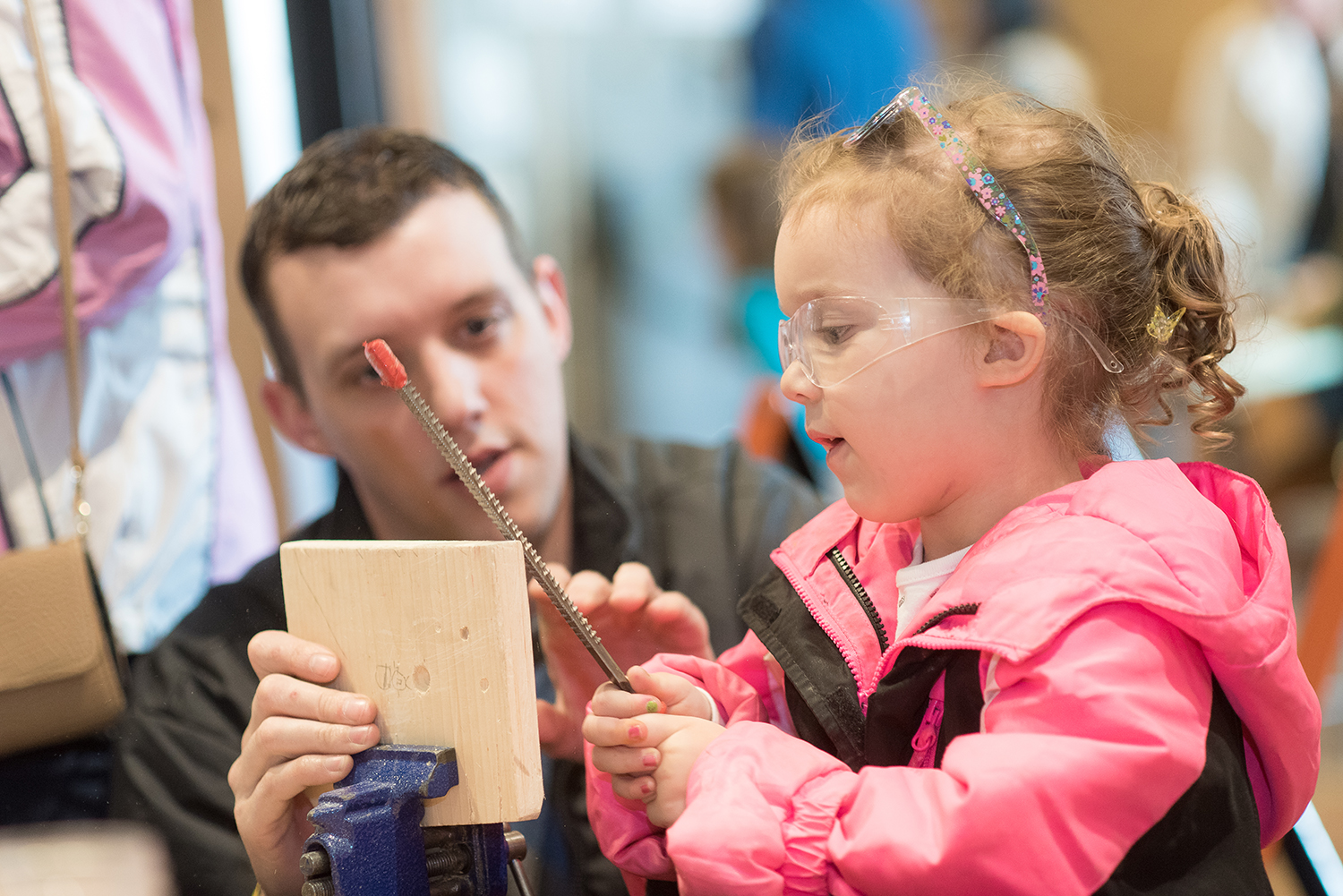
Photo by Christopher Sprowls
Hack and repurpose
Learners harness and salvage materials, tools, and processes to modify, enhance, or create a new product or process. This practice includes disassociating an object’s properties from familiar use. Engagement in this practice might look like using a two-liter bottle to model a scuba tank, or discovering that a material from one activity area has migrated across the makerspace to a different activity area and can be used in a novel way.
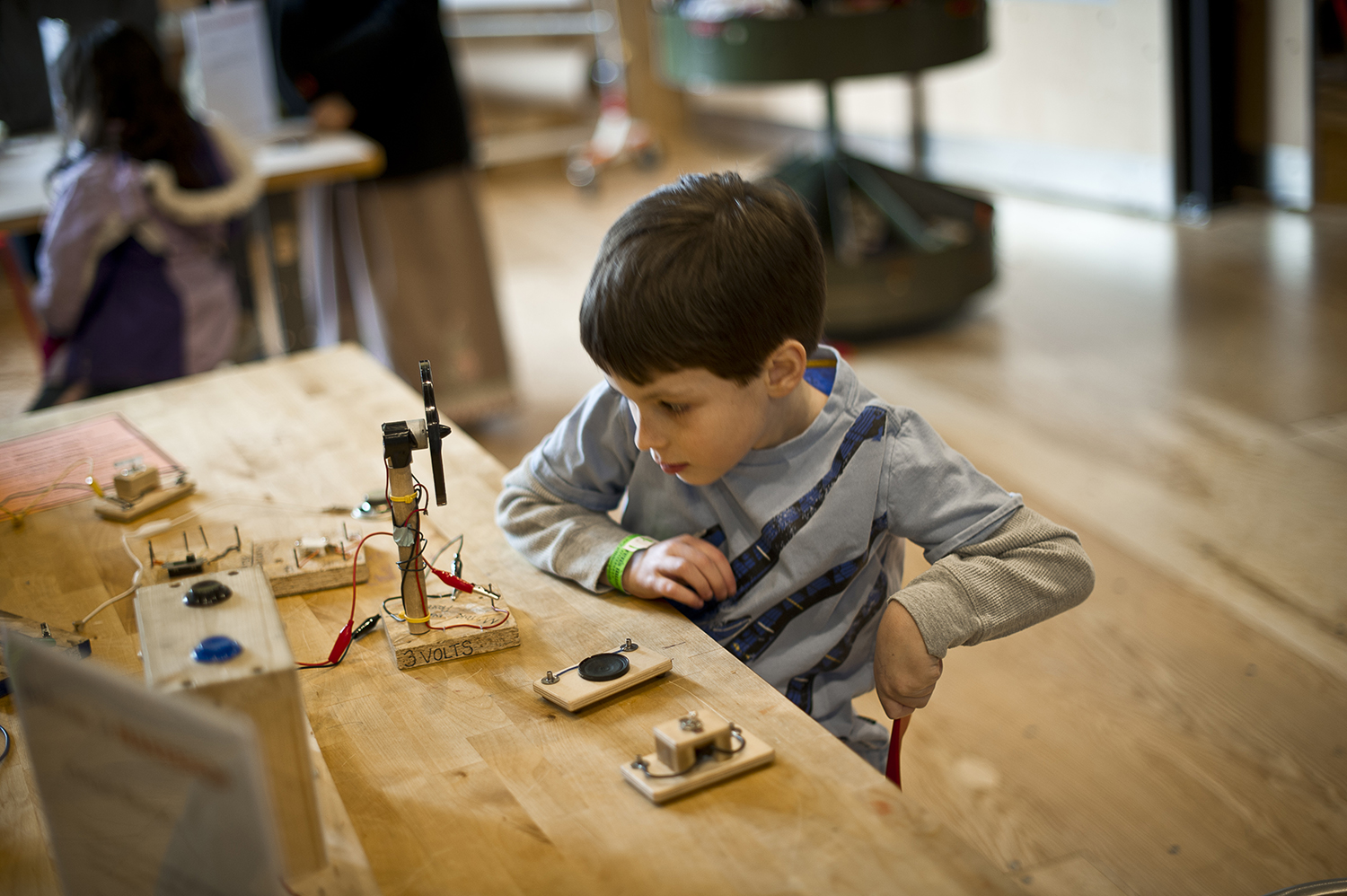
Photo by Anthony Musmanno
Develop fluency
This practice refers to learners’ development of comfort and competence with diverse tools, materials, and processes, as well as the development of craft. A child might exhibit fluency development as he or she learns to use a needle and thread to connect two portions of fabric. The stitches show how the learner’s precision improves with each iteration.

Photo by Christopher Sprowls
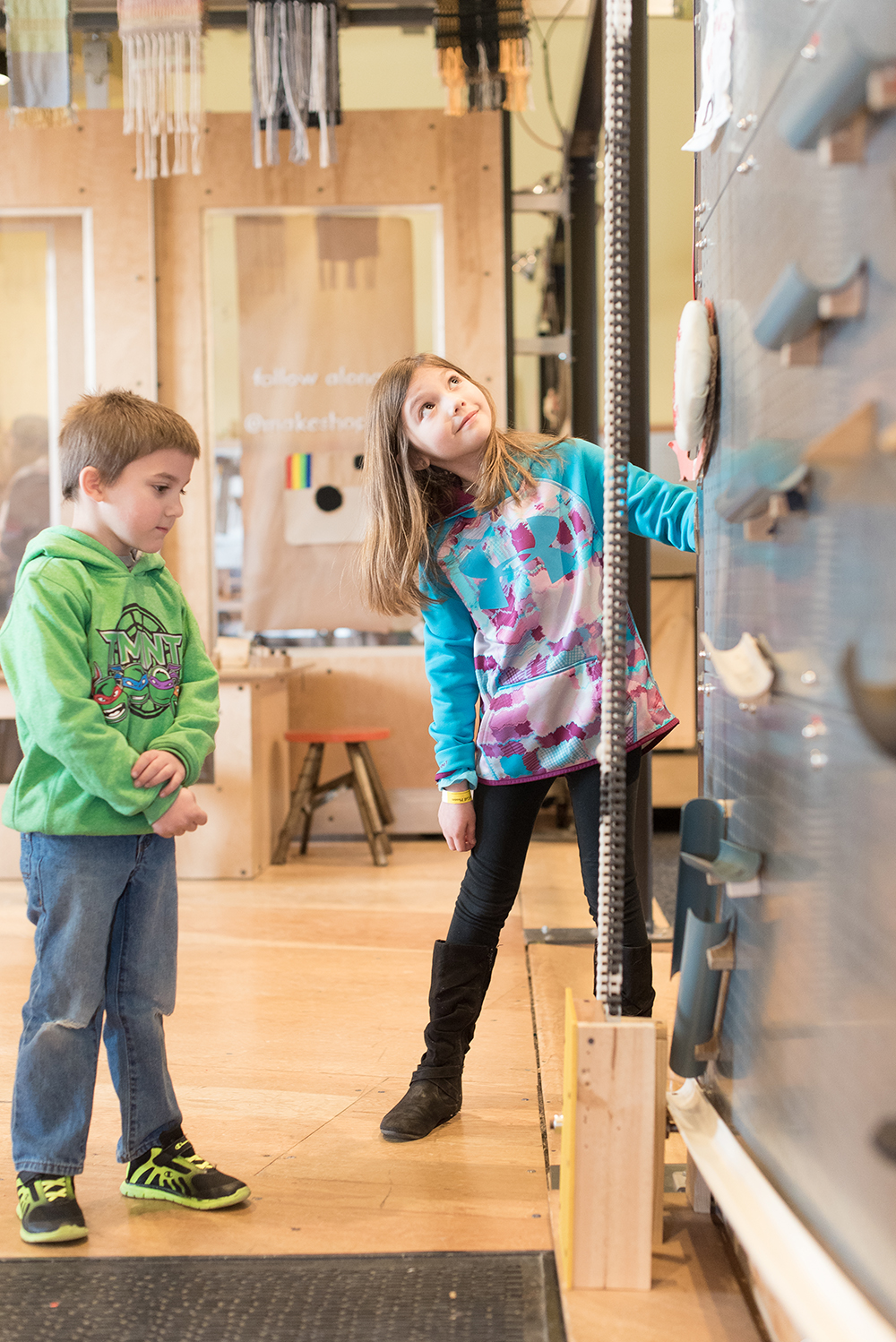
Photo by Christopher Sprowls
Simplify to complexify
Learners’ demonstrate an understanding of materials and processes by connecting and combining component elements to make new meaning. For example, when working with simple electrical circuits, a student might take a working circuit with batteries powering an LED and a motor and, by stripping down the elements, discover that by turning the motor, the LED will light without batteries in the circuit.
Seek and share resources
This practice incorporates learners’ identification, pursuit, and sharing of expertise with others, including recognition of one’s own not-knowing and desire to learn. A child might say, “Hey, look at this” when he or she has discovered a change or material property that is surprising or counterintuitive. This often is accompanied with an explanation to a parent or educator to help solidify understanding. The learner might also seek out information or ask another learner, parent, or educator, “How did you do that?”
By identifying the practices in which learners engage through participation in MAKESHOP, as well as the elements of design that are responsive to and support learners’ participation in these practices, we have developed a common language around making that is practice-based and rooted in theories of cultural and social learning (Brown, Collins, and Duguid 1989; Lave and Wenger 1991; Wenger 1998), as well as the lived experience and expertise of our staff. This common language is intended to guide discussions across settings about making as a learning process by identifying ways to conceptualize, support, and assess various forms of learning through design. Ultimately, this work enables us to make empirical claims about making based on the actions, interactions, and work of making as it is being carried out in informal and formal learning contexts.
For example, MAKESHOP teaching artists cite watching visitors engaging in “Hacking and Repurposing” as evidence for the success of the making environment, designed activities, or a particular facilitation approach. In a reflective practice cycle, MAKESHOP educators share their observations with other MAKESHOP educators and learning scientists, and adjust the approach or the space for the next day with the goal of better supporting learner engagement in the identified learning practice.
In addition to enabling our research–practice team to define learning in a way that is relevant and responsive, this intense work has revealed that successful makerspaces consist of more than a physical space with tools and work surfaces. They are more than a collection of activities or curriculum. Successful makerspaces integrate tools, materials, and activities with a well-reasoned and articulated philosophy of learning and teaching that is responsive to the people engaged in the making process—both the learners and those facilitating the experience. As museum learning scientist Peter Wardrip summarizes, “The not-so-secret, secret ingredient is the people.” Investing in the facilitators and teaching staff while aligning their approach to the clearly expressed and shared outcomes sets the stage for success.
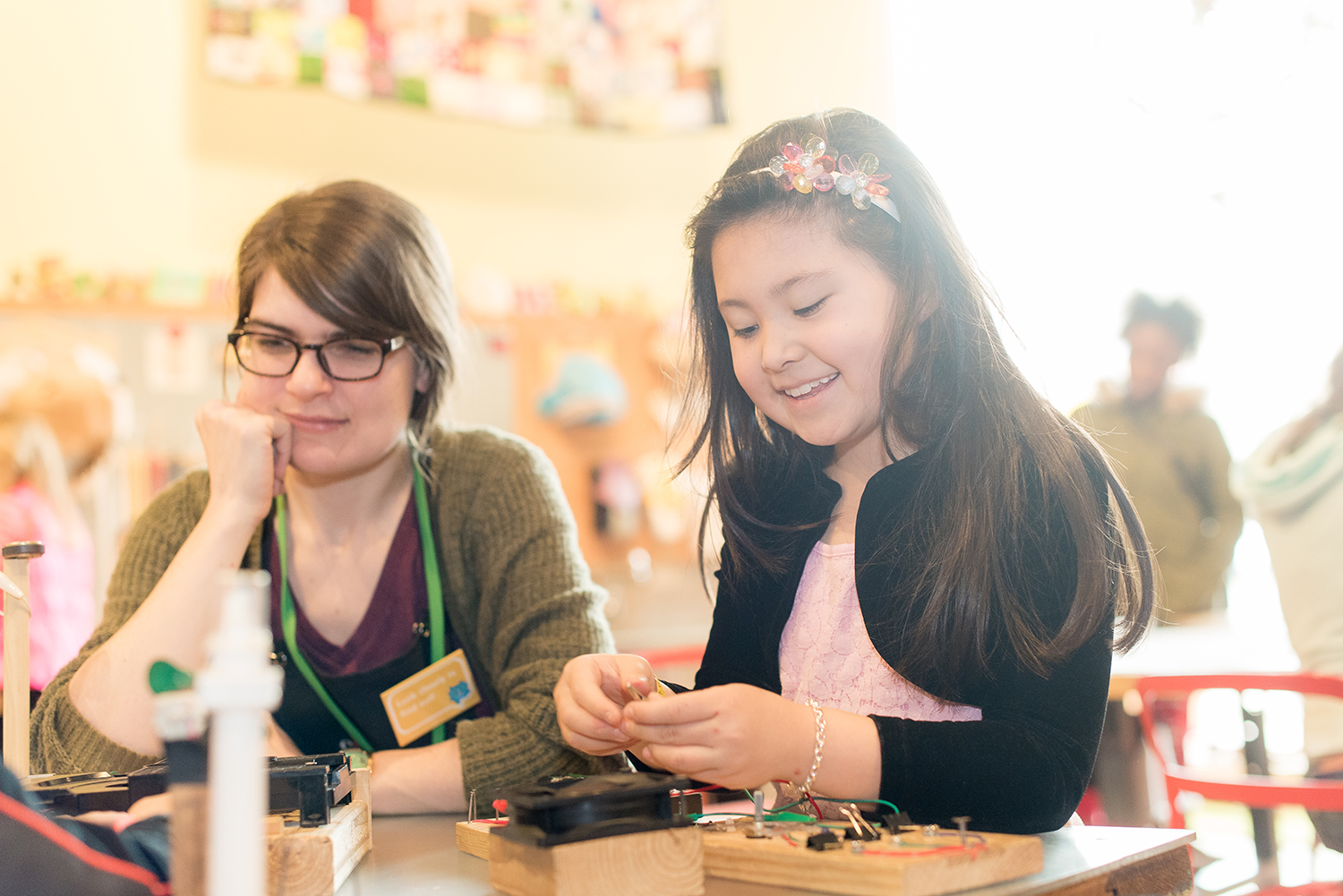
Photo by Christopher Sprowls
Sharing the MAKER phenomenon with others
One outgrowth of the Museum’s leadership in the maker education movement has been the opportunity to help others—including schools, museums, and libraries—seed and develop makerspaces as learning sites. Remaining true to our belief that an alignment of purpose and people in a makerspace is essential to its success, the Children’s Museum places great value on the role of professional development for educators and administrators in the design and creation of their makerspaces.
We have developed strategies, frameworks, and models of professional learning that have become staples for our work locally and nationally. Locally, the Children’s Museum MAKESHOP has pioneered a four-day Maker Educator Boot Camp that immerses participants in the skills and disposition of making and the strategies to support it in the classroom.
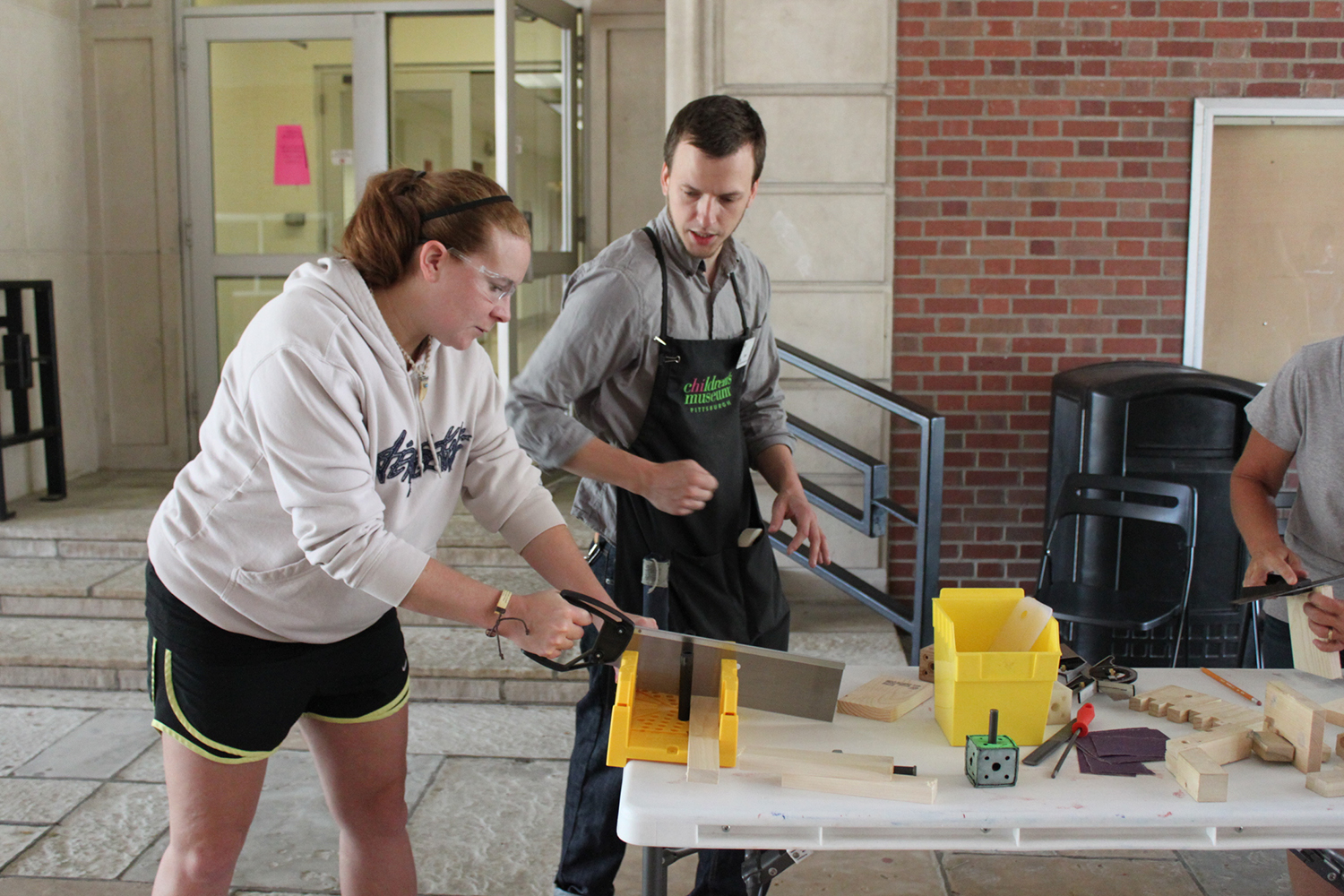
Photo courtesy of Children’s Museum of Pittsburgh
In the Maker Educator Boot Camp, facilitators encourage teachers to dive deeply into making to examine the process as learners first. After these deep-dives, Boot Camp facilitators engage teachers in discussion groups away from the tools and materials to unpack what they noticed about their learning and look at what making afforded them as a learning experience. Teachers frequently remark at the role of direct teaching of tool use compared to the little direction given regarding expected outcomes of their tinkering and making. Outcomes are diverse and come from the interests and experiences of the teacher-learners. Teaching artists’ subtle, gentle, and profound facilitation often stands in stark contrast to typical classroom practice, resulting in measurable, standardized outcomes.
During the week, facilitators keep a clear delineation between maker experiences and the “teacher talk” that can shortchange personal learning during making by putting classroom practice in the forefront. For example, if you are learning how to take apart appliances, scavenge component parts, and solder them into a new purpose, conversations about safety, classroom management, and class schedules detract from the experience. Dwelling on and reinforcing conversations about all their perceived barriers to making integration in their classrooms can leave educators stuck or resistant to imagining change. These important conversations are saved for dedicated times toward the end of the week.
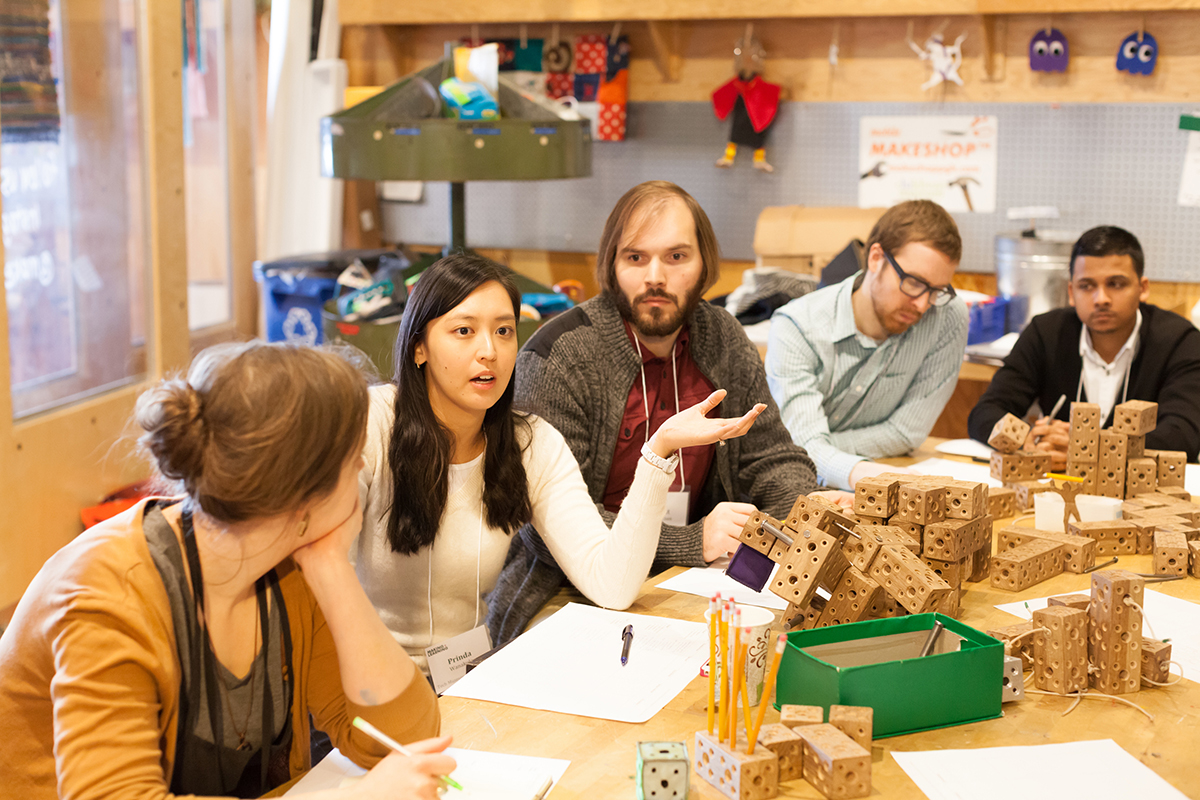
Photo by Renee Rosensteel
Teachers learn that the design of a maker activity that promotes diverse outcomes, problem-solving skills, creativity, and collaborative work can also be aligned to math, language arts, science, or even history in an authentic, cross-curricular way. For example, sewing provides opportunities to deep understanding of area and volume, woodworking tools have historical significance to colonial industry, and creating new electrical gadgets from the workings of broken appliances reinforces electrical circuit principles. In four days of deep learning; intense, meaning-making conversations; and development of a sophisticated view of making often leave teachers feeling overwhelmed, so the final day looks at techniques for documenting evidence of learning in the classroom through student reflection, photo and video logs, and other digital portfolio tools such as Seesaw. Boot Camp ends with a talk about taking initial, small steps toward the goal of integrated making experiences.
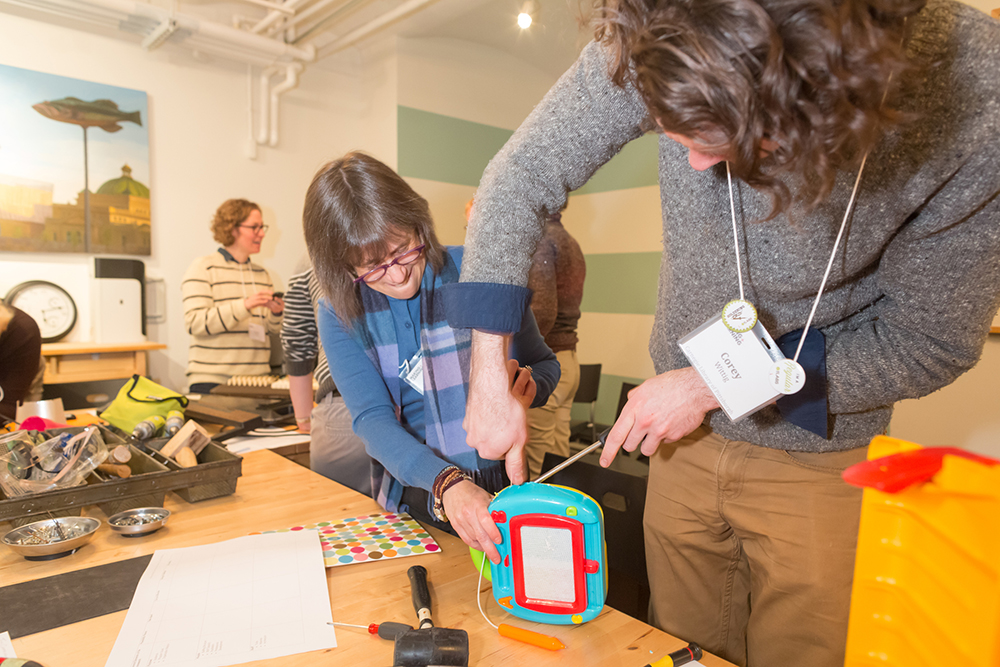
Photo by Renee Rosensteel
Implementing the MAKER education phenomenon nationwide
In concert with the teaching facilitation techniques, the Museum Business Development Department has worked with museums, libraries, and schools to design and build their own makerspaces. The museum has also partnered with organizations to scale our understanding and model for supporting making in schools nationwide.
In partnership with the Institute of Museum and Library Services, the museum created the Making + Learning Framework. Working with and visiting over 100 museum and library professionals from across the country, we developed a straightforward yet widely applicable framework that consists of three elements that we believe create the conditions for learning in museums and libraries: Purpose, People, and Pieces and Parts.
- Purpose: The success of a learning experience is incumbent upon identifying its purpose with respect to its goals, mission and affiliations, programmatic strengths, and values.
- People: The key to the success of any maker-based learning experience rests in the role people play—from design, to facilitation, to support and the learners themselves. People are at the heart of making.
- Pieces and Parts: The pieces and parts—tools, materials, equipment, and space—that are used in a maker experience should align to its purpose and the people who use them as elements of learning.
The elements of the framework are intended to guide practitioners’ planning and implementation of maker-based learning experiences. The framework and companion resources are also designed to spark discussions and encourage practitioners to consider critical factors for their maker experiences. In the spirit of making, this framework is meant to be flexible and adaptable. It is designed to support the local concerns, priorities, and conditions of any museum or library.
In addition to the framework itself, the project created a publication that describes our process and its outcome. It also includes a collection of case studies that illustrate how the elements of the framework guide makerspace and program development. Finally, a toolkit and MOOC (massive open online course) are also available to enable museum and library professionals to help staff use the framework to support learning and grow their capacity. Check out www.makingandlearning.org for more information.
Kickstarting makerspaces in schools
Moving from nonformal learning environments such museums and libraries to schools and classrooms, the museum has created a model to sustainably integrate making as a learning process into schools using crowdfunding. In 2015, the Children’s Museum of Pittsburgh collaborated with Kickstarter, the online crowdfunding platform, to develop crowdfunding as a way to raise community awareness and support to sustainably integrate making into schools. Crowdfunding is the process of collecting small amounts of money for a single project from a large number of people. Often, crowdfunding is done through a website such as Kickstarter, Donors Choose, and Ioby.
Central to the model is forming a strong partnership between schools and an educational provider that specializes in making as a learning process, such as the Children’s Museum of Pittsburgh, to establish trust and collaborative activities to support teachers, administrators, and students as they incorporate the maker-based approach into their instructional practice and school culture. This pilot initiative, called Kickstarting Making, linked 10 schools in the Pittsburgh area to the museum as the central hub.
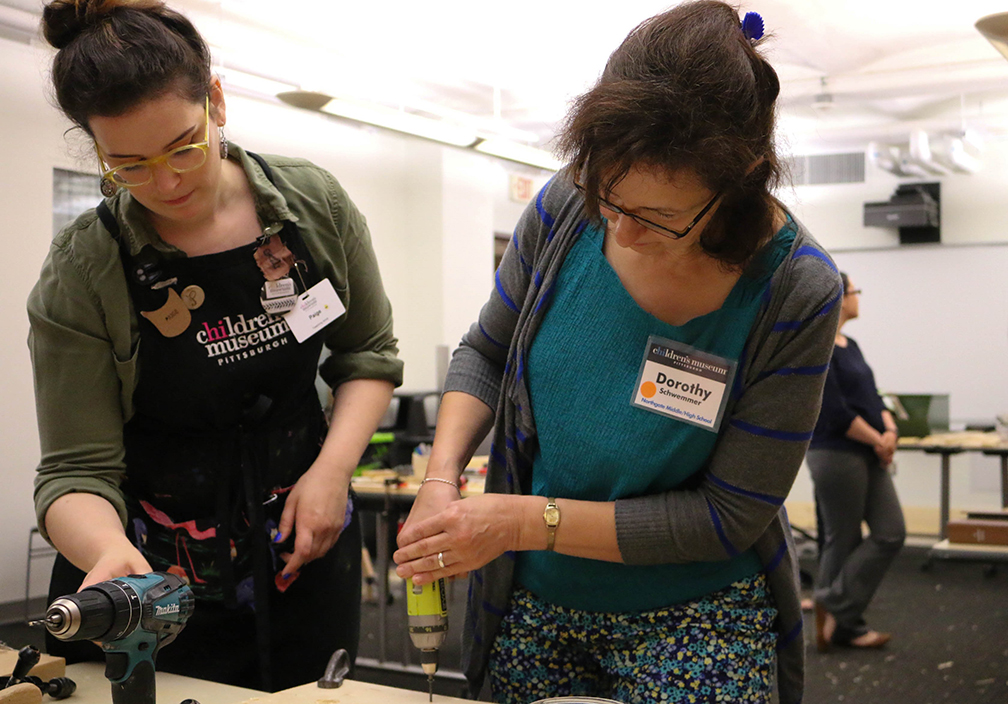
Photo courtesy of Children’s Museum of Pittsburgh
The museum worked with teams of teachers and administrators from each school to articulate the school’s goals and needs for a makerspace, and provide professional learning opportunities for teachers, administrators, and the school community. For example, teachers from each of our partner schools participated in a Maker Educator Boot Camp, specially adapted to support teachers’ development of skills and comfort with the making process, as well as their pedagogical approach to incorporating making into their classroom instructional practices. These Boot Camps also addressed the particulars of developing and running a crowdfunding campaign. Museum representatives further supported schools by having meetings with individual teachers, speaking at school board meetings, facilitating maker-based workshops for students, and providing critical feedback on the elements of each school’s crowdfunding campaign.
Of the 10 original Kickstarting Making schools, seven reached their fundraising goals in the initial attempt. Two reached their goals in the months following. Schools established their fundraising goals based on an estimate of what they could realistically achieve in their community and the scope of their specific project. For example, one school established a goal of raising $5,000 in support of a pilot project that would set the stage for making as an instructional model, whereas another school set its fundraising goal at nearly $20,000 in hopes of raising capital funds to build and outfit an outdoor makerspace at the school. In total, schools raised more than $100,000 to support the creation of their makerspaces.
Schools returned a portion of their funds back to the museum for the professional development and design services. The museum learned that school team members’ ability to clearly communicate their goals—the specific reasons why each school sought to incorporate making as a learning process into their teaching, learning, and school culture, and the expected impact it would have on these aspects of practice—was a lynchpin of success.
The goals of administrators and teachers were not necessarily aligned, achievable, or measurable at the beginning of the project, and taking the time to express these differences and adjust expectations paid big dividends. Based on these findings, the Museum created a toolkit to help surface the underlying assumptions of the teams and provide a means to speak clearly to administrators, educators, parents, and community stakeholders about their maker initiative.
The success of Kickstarting Making served as an innovative proof of concept for the field. At the end of 2015, Google became interested in scaling the project to the national level and provided more than $1 million in funding through their Making & Science initiative for the effort. The Children’s Museum looked to its longtime partner, the Maker Education Initiative (Maker Ed), as an important ally in this ambitious new project. Based in Oakland, California, Maker Ed is a project of the Tides Center and forms the nonprofit arm of Make Media. Maker Ed’s mission is “Every Child a Maker,” and it brought robust training resources and a far-reaching community of support to the project.
The new national effort, Making Spaces: Expanding Maker Education Across the Nation is an innovative strategy to create an interlinked network of regional hubs to sustainably integrate making into schools across the country. Participating schools are paired with a nearby regional hub, such as a museum, library, or community organization. The regional hub acts as a center of professional development and the coordination point for school partners.
The toolkit developed through Kickstarting Making now helps participating hubs and schools structure and articulate their diverse needs and aspirations for a makerspace into a coherent and compelling value proposition for their community.
In the 2016–2017 academic year, the Making Spaces project identified 10 hubs across the country that included museums, libraries, public education–related institutions, and community-based organizations. The first cohort of national hubs included:
- Children’s Museum of Pittsburgh (Pittsburgh, Pennsylvania)
- Maker Ed (Oakland, California; will work virtually with non-colocated schools)
- The Scott Family Amazeum (Bentonville, Arkansas)
- KID Museum (Bethesda, Maryland)
- Edventure Children’s Museum (Columbia, South Carolina)
- Montshire Museum of Science (Norwich, Vermont)
- Albemarle County Public School District (Charlottesville, Virginia)
- Digital Youth Network at DePaul University (Chicago, Illinois)
- San Mateo County Office of Education (Redwood City, California)
- The Bubbler at Madison Public Library (Madison, Wisconsin)
These hubs in turn selected 5 to 10 regional schools that expressed a keen interest and internal capacity to bring their own expertise in making and educator professional development to support a maker initiative. The Children’s Museum and Maker Ed served as national partners, providing support, training, and connections to participating hubs. These hubs, in turn, support, train, and connect schools, creating a national resource network. Through this work, schools and districts across the country have partnered to create and execute successful crowd-funded campaigns using a variety of crowdfunding platforms and established makerspaces and/or maker-based programs within their schools. On average, each school has raised $2,000, totaling nearly $500,000 at the close of the school year. As the 2017–2018 school year began, some campaigns were still in operation to help raise additional funds, and more importantly, to continue to raise community awareness and support.
Participating hubs overwhelmingly reported that among its affordances, the crowdfunding campaign development process was most beneficial in helping schools establish a clear and focused vision for the integration of making into the school culture and curriculum, and for strengthening relationships among the school community, bringing it back to Purpose and People. Schools are able to leverage these vision statements and partnerships to seek or reallocate additional funding and community support to sustain their making beyond the campaign. At the start of the 2017–2018 school year, the program has welcomed five additional regional hubs into the network.
Makerspaces, whether they be in a library, museum, classroom, or school cafeteria, come in all shape and sizes, with necessarily varied goals and approaches for learning. However, by thoughtfully aligning the unique and meaningful learning goals of a makerspace with the strengths of its instructional team, formal and nonformal educational institutions can work together to catalyze conversations, awareness, and actions that lead to real, positive, and sustainable change.
Chip Lindsey (clindsey@pittsburghkids.org) is director of education at the Pittsburgh Children’s Museum in Pittsburgh, Pennsylvania. Lisa Brahms (lbrahms@pittsburghkids.org) is director of learning and research at the Pittsburgh Children’s Museum in Pittsburgh, Pennsylvania. Kathryn Koffler (kkoffler@PittsburghKids.org) is manager of Making Spaces at the Pittsburgh Children’s Museum in Pittsburgh, Pennsylvania.


